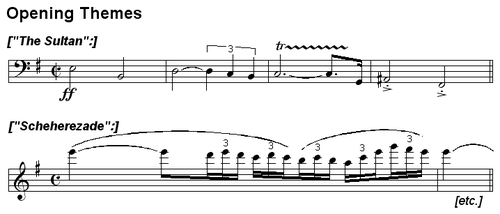Scheherazade (Rimsky-Korsakov)
Scheherazade (Шехерезада in Cyrillic, Šekherezada in transliteration), Op. 35, is a symphonic suite composed by Nikolai Rimsky-Korsakov in 1888. Based on The Book of One Thousand and One Nights, this orchestral work combines two features common to Russian music, and of Rimsky-Korsakov in particular: dazzling, colorful orchestration and an interest in the East, which figured greatly in the history of Imperial Russia.
The music was used in a Ballet by Michel Fokine.
Instrumentation
The work is scored of two flutes and piccolo, two oboes, cor anglais, two clarinets, two bassoons, four horns, two trumpets, three trombones, tuba, timpani,bass drum, snare drum, cymbals, triangle, tambourine, tam-tam, strings, harp.[1]
Structure, themes and musical material
The suite is divided into four movements. The composer was persuaded to give them programmatic titles as follows, but later removed them in favor of mere tempo markings and discouraged attempts to read literal storytelling into the music.
- I. The Sea and Sinbad's Ship (Largo e maestoso — Allegro non troppo)
- II. The Kalendar Prince (Lento — Andantino — Allegro molto — Con moto)
- III. The Young Prince and The Young Princess (Andantino quasi allegretto — Pochissimo più mosso — Come prima — Pochissimo più animato)
- IV. Festival At Baghdad. The Sea. The Ship Breaks against a Cliff Surmounted by a Bronze Horseman. (Allegro molto — Vivo — Allegro non troppo maestoso)
The musical theme which opens the first movement is supposed to represent the domineering Sultan. But soon (after a few chords in the woodwinds reminiscent of the opening of Mendelssohn's Midsummer Night's Dream overture), we hear the one theme that appears in every movement; this represents the character of the storyteller herself, Scheherazade, his wife, who eventually succeeds at appeasing him with her stories. This is a haunting, sensuously winding melody for violin solo, accompanied by harp. Both of these two themes are shown below.
Premiere
The music premiered in St. Petersburg on October 28, 1888 conducted by Rimsky-Korsakov.[1]
Ballet
Michel Fokine used part of Rimsky-Korsakov's music to stage a ballet in collaboration with Léon Bakst. Fokine did the choreography, Bakst designed the sets and costumes, while they jointly wrote the libretto after the first story of The Book of One Thousand and One Nights. The ballet premiered on June 4, 1910 by Diaghilev's Ballets Russes.
In popular culture
- Movements 1 and 2 were featured in the movie The Man with One Red Shoe.
- Movement 1 was used in a promotional trailer and a fan restoration of The Thief and the Cobbler.
- Movement 1 was featured in the movie A Clockwork Orange when the main character Alex DeLarge imagines himself whipping Jesus. Movement 2 was used when Alex imagines himself sleeping with the handmaidens of his wife.
- In You Can't Take it With You, Edward Carmichael plays the 1st movement on the xylophone.
- Movements 1 and 2 were used in the anime TV series Princess Tutu.
- In the 1968 Deep Purple album Shades of Deep Purple, the first two or so minutes of the fourth track "Prelude: Happiness" is a direct translation of the first movement of Scheherazade.
References
- ^ a b Paul Schiavo. "Program Notes". Saint Louis Symphony Orchestra. Retrieved 2007-07-06.
External links
- Performance of Scheherazade by the Peabody Institute (MP3)
- Scheherazade, 1001 Nights Retold in a Symphony -- story with link to audio interview on NPR's *Weekend Edition Saturday (Scott Simon interviewing Marin Alsop)
- About the ballet

